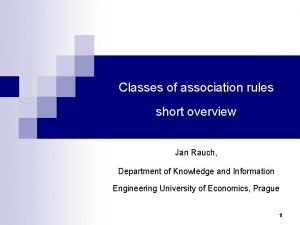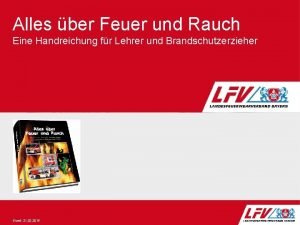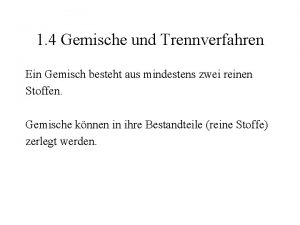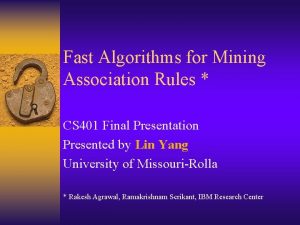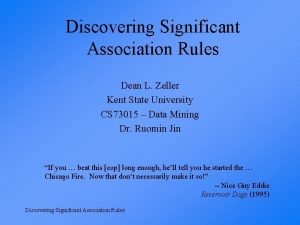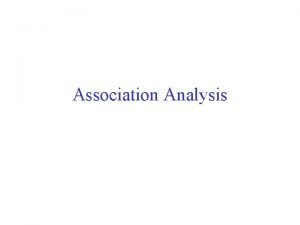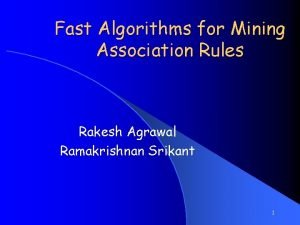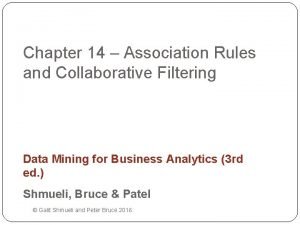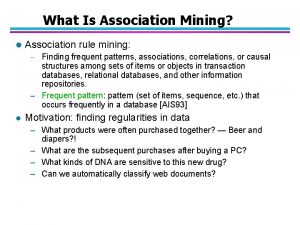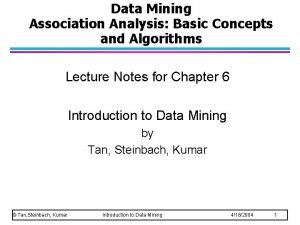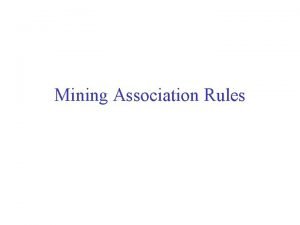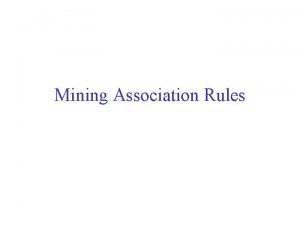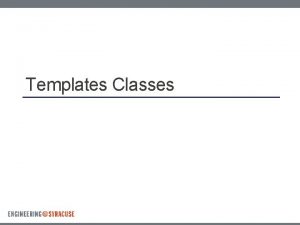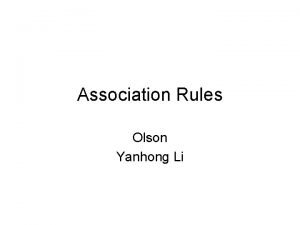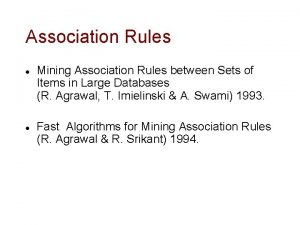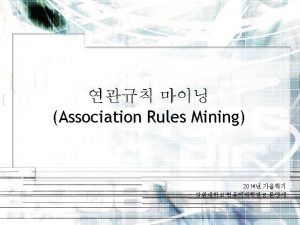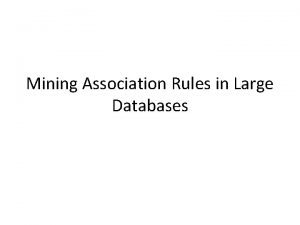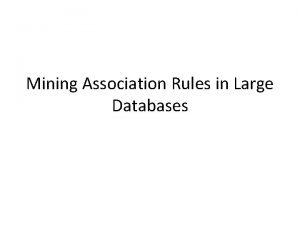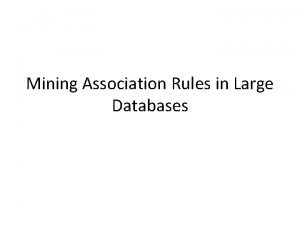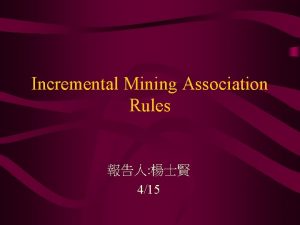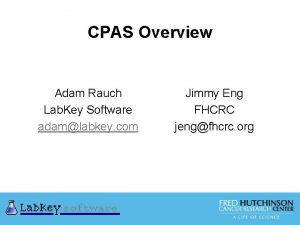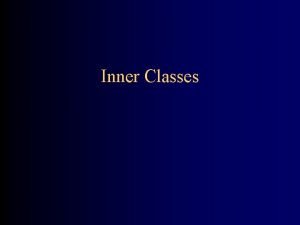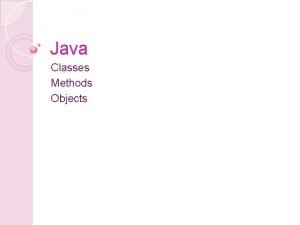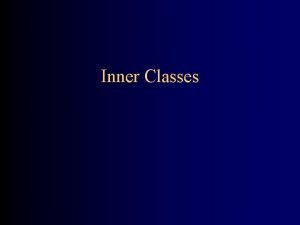Classes of association rules short overview Jan Rauch





















- Slides: 21

Classes of association rules short overview Jan Rauch, Department of Knowledge and Information Engineering University of Economics, Prague 1

Classes of association rules – overview n Introduction, classes of rules and quantifiers n Implicational quantifiers n Deduction rules for implicational quantifiers n Tables of critical frequencies for implicational quantifiers n - double implication 4 ft quantifiers n - equivalence 4 ft quantifiers n 4 ft quantifiers with F-property 2

Classes of association rules – Introduction n Simple intuitive definition n Each class contains both simple association rules and comlex association rules corresponding to statistical hypothesis tests n Important both theoretical and practical properties n Examples: ¨ imlicational association rules ¨ double imlicational association rules ¨ -double imlicational association rules ¨ equivalency association rules ¨ - equivalency association rules ¨ rules with F-property 3

Literature Hájek, P. - Havránek T. : Mechanising Hypothesis Formation – Mathematical Foundations for a General Theory. Berlin – Heidelberg - New York, Springer-Verlag, 1978, 396 pp, http: //www. cs. cas. cz/~hajek/guhabook/ Rauch, J. : Logic of Association Rules. Applied Intelligence, 2005, No. 22, 9 -28 Rauch, J. : Classes of Association Rules, An Overview. In: LIN, T. Y. Ying, X. (Ed. ): Foundation of Semantic Oriented Data and Web Mining. Proceedings of an ICDM 2005 Workshop, IEEE Houston 2005. pp 68 – 74. http: //www. cs. sjsu. edu/faculty/tylin/ICDM 05/proceeding. pdf 4

Classes of 4 ft-quantifiers Association rule belongs to the class of association rules if and only if the 4 ft-quantifier belongs to the class of 4 ft-quantifiers Examples: n association rule is implicational iff is implicational n association rule is -double implicational iff is -double implicational n association rule is - equivalency iff is - equivalency 5

* is implicational quantifier M M’ a c b d a’ c’ b’ d’ M’ is better from the point of view of implication: a’ a b’ b If *(a, b, c, d) = 1 and a’ a b’ b then *(a’, b’, c’, d’) = 1 Truth Preservation Condition for implicational quantifiers: TPC : a’ a b’ b * is implicational: If *(a, b, c, d) = 1 and TPC then *(a’, b’, c’, d’) = 1 6

Implication quantifiers – examples (1) Founded implication: p, B (a, b, c, d) = 1 iff a’ a b’ b: Founded 2 b - implication: p, B (a, b, c, d) = 1 iff 7

Implication quantifiers – examples (2) Lower critical implication for 0 < p 1, 0 0. 5: !p; (a, b, c, d) = 1 iff The rule !p; corresponds to the statistical test (on the level ) of the null hypothesis H 0: P( | ) p against the alternative one H 1: P( | ) > p. Here P( | ) is the conditional probability of the validity of under the condition . a’ a b’ b: 8

Deduction rules (1) Is the deduction rule M A A E a c E b d correct? M E F (E F) A a’ b’ A c’ d’ we see: a’ a b’ b and TPC thus if 0. 9, 50(a, b, c, d) = 1 then also 0. 9, 50(a, b, c, d) = 1 Yes, the deduction rule is correct. 9

Deduction rules (2) Is the deduction rule M A A E a c E b d correct? M E F (E F) A a’ b’ A c’ d’ we see: a’ a b’ b and it is TPC and thus if !0. 95, 0. 05(a, b, c, d) = 1 then also !0. 95, 0. 05(a, b, c, d) = 1 Yes, the deduction rule is correct. 10

Deduction rules (3) Additional correct deduction rules (prove it home): Question: * implication quantifier: iff ? ? ? 11

Deduction rules – two notions Associated propositional formula ( ) associated to Boolean attribute : Rule p, B e. g. A B C p, B D E F A, B, C, B, D, E, F are Boolean attributes ( ): Boolean attributes propositional variables ( ) = A B C ( ) = D E F A, B, C, D, E, F are propositional variables, we can decide if ( ) is a tautology 12

Deduction rules – two notions Implicational quantifier is interesting: I is a – dependent , b – dependent and (0, 0, c, d) = 0 is a - dependent if exists a, a’, b, c, d : (a, b, c, d) (a’, b, c, d) 0. 9, 50, !0. 9, 0. 05 are interesting implication quantifiers 13

Correct Deduction Rules is the correct deduction rule iff 1) or 2) are satisfied: 1) both (X) (Y) (X’) (Y’) and (X’) (Y’) (X) (Y) are tautologies 2) (X) (Y) is a tautology 14

Correct Deduction Rules Example: is correct because of A B E A (E B) and A ( E B) A B E are tautologies 15

Table of Critical Frequencies implication quantifier: if *(a, b, c, d) = 1 and a’ a b’ b then *(a’, b’, c’, d’) = 1 * is c, d independent, thus *(a, b) instead of *(a, b, c, d) Table of maximal b for *: Tb *(a) = min {e| *(a, e) = 0} *(a, b)= 1 iff b < Tb * (a) 16

Table of maximal b b a 17

Class of - double implication 4 ft quantifiers M X X Y a c Y b d True Preservation Condition: M’ X X Y a’ c’ Y b’ d’ a’ a b’ + c’ b + c example: X p Y a/(a + b + c) p TCF: Tb *(a) = min{b+c| *(a, b, c) = 0} *(a, b, c)= 1 iff b + c < Tb * (a) is correct iff. . . 18

Class of - equivalence 4 ft quantifiers M X X Y a c Y b d True Preservation Condition: M’ X X Y a’ c’ Y b’ d’ a’ + d’ a + d b’ + c’ b + c example: X p Y (a + d)/(a+b+c+d) p TCF: Tb *(F) = min {b+c | *(a, b, c, d)=0 a+d=F} *(a, b, c, d)= 1 iff b + c < Tb *(a + d) is correct iff. . . 19

4 ft quantifiers with F-property has the F-property if it satisfies 1) If (a, b, c, d) = 1 and b c – 1 0 then (a, b+1, c-1, d) = 1 2) If (a, b, c, d) = 1 and c b – 1 0 then (a, b -1, c+1, d) = 1 If is symmetrical and has the F-property then there is a function T (a, d, n) such that for a+b+c+d = n is (a, b, c, d) = 1 iff | b-c | T (a, d, n) Fisher’s quantifier and 2 quantifier have the F-property 20

AA - quantifier has F-property 21
 Short short short long long long short short short
Short short short long long long short short short Jan rauch
Jan rauch Feuer freund und feind
Feuer freund und feind Chromatographie genutzte eigenschaft
Chromatographie genutzte eigenschaft Philippe rauch
Philippe rauch Fraunhofer moez
Fraunhofer moez Marion rauch
Marion rauch Kelvin rodolfo
Kelvin rodolfo Qualquer classe e subclasse
Qualquer classe e subclasse Pre ap classes vs regular classes
Pre ap classes vs regular classes Worcester state starfish
Worcester state starfish Hidden rules among classes
Hidden rules among classes Fast algorithms for mining association rules
Fast algorithms for mining association rules Spurious association
Spurious association Association
Association Fast algorithms for mining association rules
Fast algorithms for mining association rules Association rules vs collaborative filtering
Association rules vs collaborative filtering Define association rule mining
Define association rule mining Association rules in data mining
Association rules in data mining Association rules in data mining
Association rules in data mining Association rules in data mining
Association rules in data mining Association rules in data mining
Association rules in data mining

